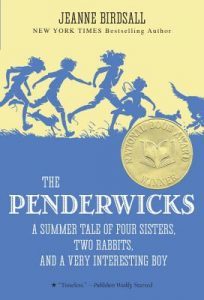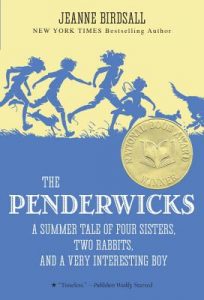craft review by Anne-Marie Strohman
If you are looking for mentor text for both character development and an effective use of multiple viewpoints, The Penderwicks books are the perfect place to start. Not only does Jeanne Birdsall, author of The Penderwicks series, have a special knack for creating well-rounded characters who leap off the page, she also passes the point of view baton from one character to the next with uncommon skill. Anne-Marie breaks down Birdsall’s craft into specific tactics to improve any writer’s game. This is a post well-deserving of a second read. –Kristi

The subtitle of The Penderwicks–A Summer Tale of Four Sisters, Two Rabbits, and a Very Interesting Boy–describes both why readers love the book (all those characters!) and a huge challenge for the author (all those characters!). Arguably, the plot arc of this first installment in Jeanne Birdsall’s series is Jeffrey’s story, the “interesting boy” of the subtitle. But from the very beginning, our hearts are with the four sisters. Birdsall makes us love them through their strong voices, and through the perspective of the narrator.
Start with contrast
The book opens with an omniscient narrator; however, Birdsall immediately introduces and distinguishes between two of the sisters:
For a long time after that summer, the four Penderwick sisters still talked of Arundel. Fate drove us there, Jane would say. No, it was the greedy landlord who sold our vacation house on Cape Cod, someone else would say, probably Skye (1).
Beyond giving the book a nostalgic feel by looking back at the events of the story in the past, Birdsall establishes Jane’s romantic vision of the world and Skye’s practical one.
Action: If you’re writing in third person, try introducing two contrasting characters through key language or dialogue.
Establish Voice through Dialogue
The language of the opening repeats as the chapter shifts to the main timeline of the story. First Skye:
‘It’s Batty’s fault,’ said Skye.
‘No it’s not,’ said Batty.
‘Of course it is,’ said Skye. ‘We wouldn’t be lost if Hound hadn’t eaten the map, and Hound wouldn’t have eaten the map if you hadn’t hidden your sandwich in it’ (2).
Skye is a realist who places blame–she’s a rounder character than this description implies, but her voice is clear from the beginning. The next line changes speakers, and we as readers don’t even need a dialogue tag to identify the speaker:
‘Maybe it’s fate that Hound ate the map. Maybe we’ll discover something wonderful while we’re lost’ (3).
Yes–Jane. By repeating the word “fate” so close to the start of Jane’s line, and with the emphasis the word has in the novel’s opening, we connect this romantic view of the world to Jane, the writer and creative soul of the family.
Action: Establish a character’s voice from the start in dialogue. Use key words from a character’s vocabulary to establish their voice and perspective on the world.
Report Conversation to Juxtapose Characters or Introduce Sensitive Topics
In the opening section, Birdsall gives us a shorthand for the four Penderwick girls’ individual voices by juxtaposing all of them–similar to the initial contrast between Jane and Skye–but this time in a simulated conversation about Arundel, their home that summer, that also introduces the fact that their mother has died.
He didn’t know what he was getting us into, Batty would say. Rosalind always said, It’s too bad Mommy never saw Arundel–she would have loved the gardens. And Jane would say, There are much better gardens in heaven. And Mommy will never have to bump into Mrs. Tifton in heaven, Skye added to make her sisters laugh (2).
In this nostalgic paragraph, we get a sense of Batty’s gentleness, Rosalind’s role as the keeper of her mother’s memory, Jane’s romanticism, and Skye’s humor. And Birdsall’s gentleness toward her young readers is evident here. She puts the mother’s death in a reflective moment where the sisters have some distance from it. The mother’s death is felt throughout the book, but primarily in the ways Rosalind takes responsibility for the younger three, and how they all take responsibility for each other.
Action: Experiment with simulated conversation to juxtapose a number of important characters and/or to introduce a sensitive topic. Use the conversation to foreshadow important elements of the story (here, Mrs. Tifton and her gardens).
Use Rituals and Games to Establish Connections
More important than their differences and easily distinguished voices, these sisters work together as a team. And arguably, it’s this aspect of the novel that makes it so appealing. We see their cohesiveness in the initial reminiscence of the opening, but we also see it through their interactions and their family codes and practices.
For instance, the girls swear “on the Penderwick Family Honor” regularly, and eventually invite Jeffrey to do so. They have MOPS–Meeting of the Penderwicks Sisters–and the OAP, Oldest Available Penderwick, is the responsible party in any given circumstance.
Action: Create uniting rituals, games, or language to establish the cohesiveness of a group of characters.
In some ways, the Penderwicks are the setting for Jeffrey’s story–he is the one who takes action and who changes over the course of the story. His acceptance as an Honorary Penderwick signals the climactic scene. But the Penderwick sisters–separately and together–draw readers in and keep them there.
If you want to read more about the craft of writing characters readers will relate to and love, see this post on how Lisa Ramee brought her middle grade characters to life in A GOOD KIND OF TROUBLE and also this post on how Jason Reynold’s helped readers connect to his main character in GHOST.
Anne-Marie Strohman (co-editor) writes picture books, middle grade novels, and young adult short stories and novels. She is trained as a teacher, an editor, and a scholar, specializing in Renaissance Literature. She holds an MFA in Writing for Children and Young Adults from Vermont College of Fine Arts and is an active member of SCBWI. Find her at amstrohman.com and on Twitter @amstrwriter.

COMMENTs:
0